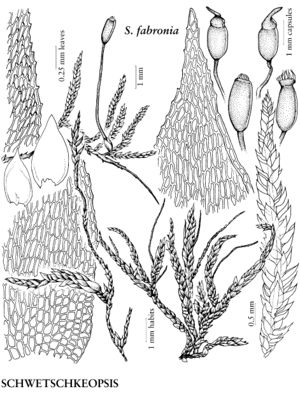Schwetschkeopsis fabronia
in H. G. A. Engler and K. Prantl, Nat. Pflanzenfam. 227/228[I,3]: 878. 1907.
Plants dark olive green. Stems usually conspicuously wider than branches, branches prostrate or ascending, simple or rarely with small secondary branches, often flagelliform, usually all pointing same direction. Leaves ovate-lanceolate, 0.5–0.7 × 0.3–0.4 mm; apex acute to acuminate; proximal laminal cells 8–17 × 10–13 µm; medial and distal cells 30–50 × 7–10 µm, mammillose abaxially due to projecting distal ends. Seta 0.4–0.8 cm. Capsule 1–1.4 mm; exostome teeth triangular-lanceolate, 240–350 × 40–50 µm. Spores 11–16 µm.
Phenology: Capsules mature Oct, Feb.
Habitat: Base of hardwoods, acidic and basic rock
Elevation: low to moderate elevations (100-1200 m)
Distribution

Ala., Ark., Conn., Del., Fla., Ga., Ill., Ind., Ky., La., Md., Mass., Mich., Miss., Mo., N.H., N.J., N.Y., N.C., Ohio, Okla., Pa., S.C., Tenn., Tex., Va., W.Va., West Indies (Cuba), e Asia.
Discussion
Schwetschkeopsis fabronia is a very slender, delicate moss typically with an evenly combed appearance due to the branches generally being directed downward in an orderly fashion. Clasmatodon parvulus is somewhat similar to and often occurs with S. fabronia. In the field, Clasmatodon can generally be distinguished from Schwetschkeopsis by its dull color and less even branch arrangement. The stems and branches of Clasmatodon are similar in size, while in Schwetschkeopsis the stems are generally noticeably larger than the branches. Microscopically the two are easily separated by the well-developed single costa of Clasmatodon versus the faint, short and double or frequently absent costa of Schwetschkeopsis. Many colonies of Schwetschkeopsis have stems composed almost entirely or in part of long, flagellate branches. Both H. A. Crum and L. E. Anderson (1981) and W. D. Reese (1984) reported that Schwetschkeopsis is ecostate, but many leaves exhibit a very faint, short, double costa. Only four collections, two each from Florida and Tennessee, were observed with mature sporophytes (two in October, two in February).
Selected References
None.
